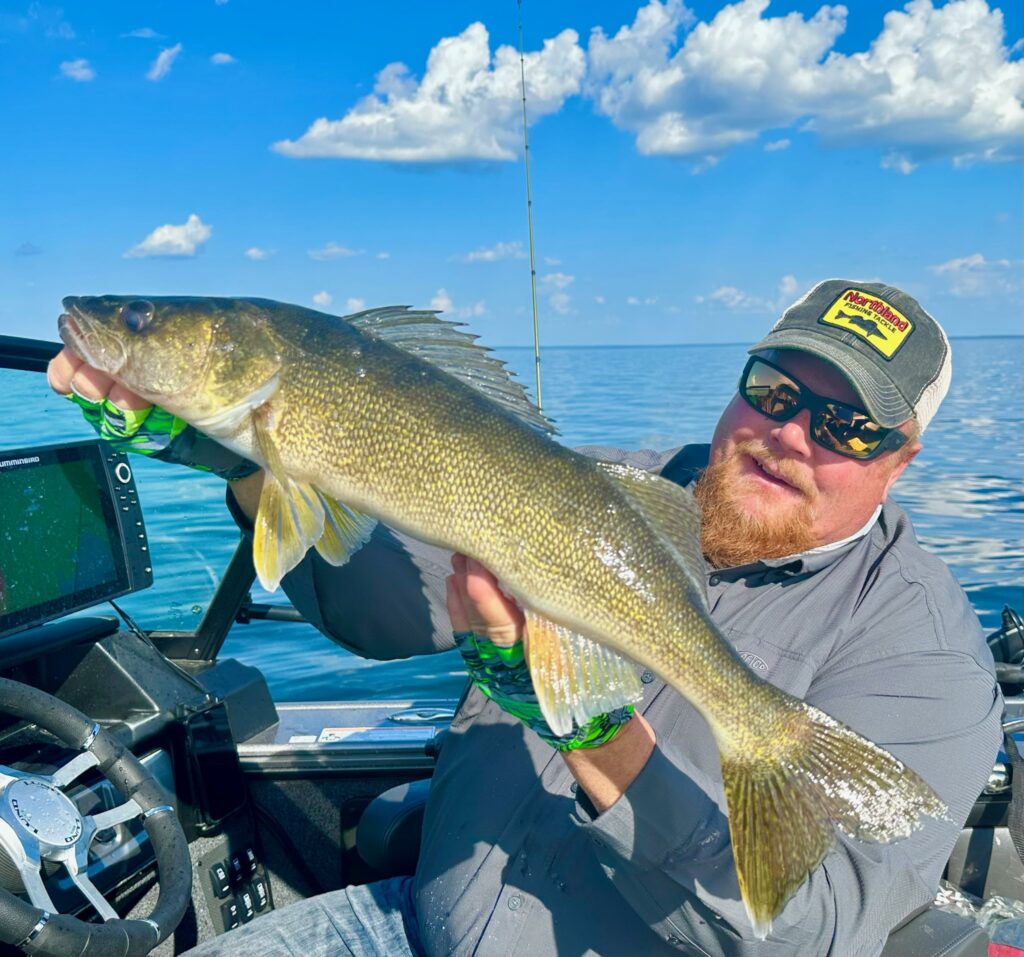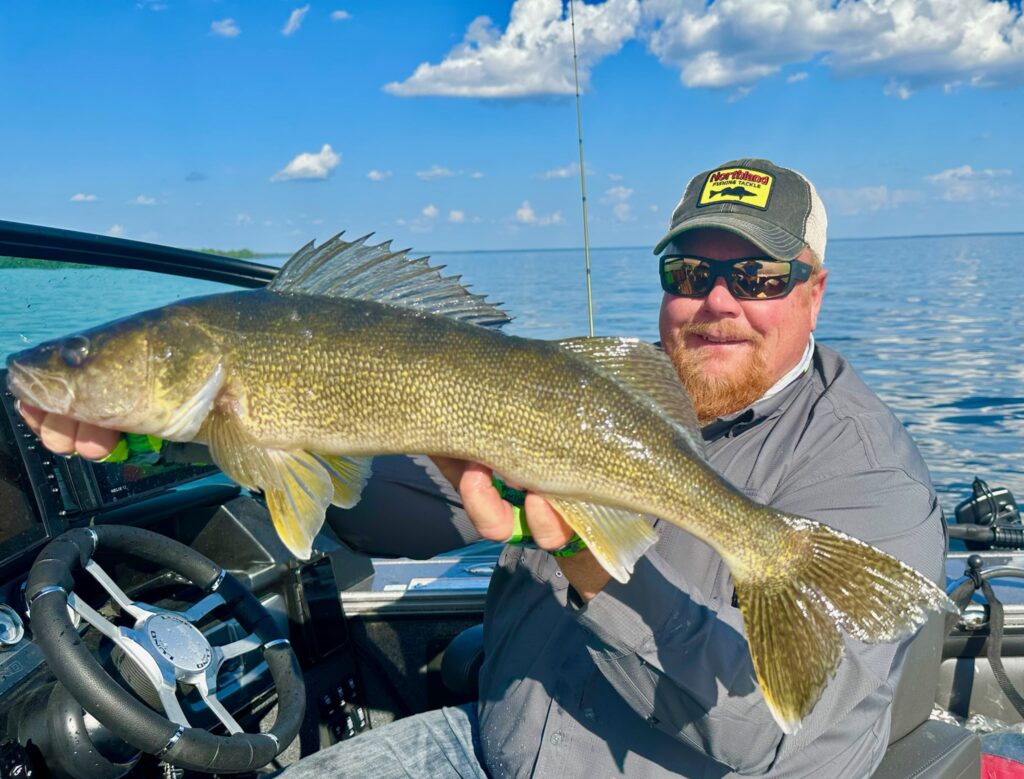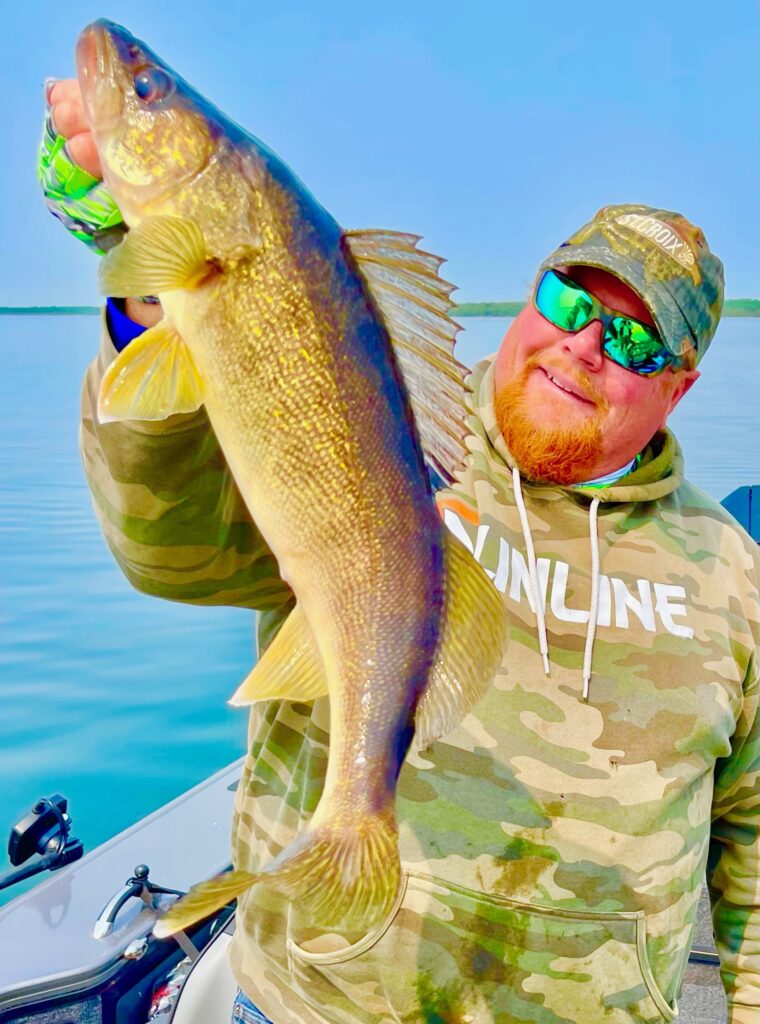Veteran fishing guide Brian “Bro” Brosdahl spills the beans on go-to tactics for ‘eyes in transition

The transition from late-summer to fall can be an exciting time of year for walleye anglers. Especially for anglers who tire of the dog days’ lead-core and bottom bouncing, this time of year means a return to pitching, jigging, cast-cranking, drop-shotting, and other techniques that honestly feel better in the hand.
We picked the brain of Max, Minnesota-based walleye wizard, Brian “Bro” Brosdahl who’s been guiding northern Minnesota for 30 years. What’s his program for late-summer to fall transition walleyes? You might just be surprised…
#1 – Drop-Shotting: Bro’s ‘Stealth Rig’
“Weeds will slowly start dying off,” says Bro. “But there’s still algae on the bottom, so a lot of times during this time of year I turn to a drop-shot, specifically my ‘Stealth Rig’ which features a horizontal dropper line off the drop shot rig itself. So, my hook is not tied into the vertical leader; it comes off another piece of line off to the side. I’ll dress a plain hook with a bead or use a floater and whatever live bait or plastic the fish want that given day.”
“The thing I like about the ‘Bro Stealth Rig’ is you can deliver your bait at exactly the depth that the walleyes are at in the water column, which is now very easy to discern with forward-facing sonar. Even in waves, I can cast sideways from the boat and slowly nudge the rig back to the boat at the walleyes’ level. If it’s really windy, just put on a heavier cylindrical drop-shop sinker,” continues Bro.
“I toss it into the pod of fish and lower the rod tip and lift slowly to barely twitch the leech or whatever bait I’m using. This year I’ve been fishing a lot of the Northland Eye-Candy soft plastics which float and work great on a drop-shot rig.”
#2 – Pitching Crankbaits

Bro says that if there’s one tactic that more walleye anglers should employ during the summer-fall transition period, it’s pitching crankbaits.
“I always have rods rigged this time of year to pitch Northland Rumble Bugs, which dive 4-7 feet or 8-10 feet, depending on whether you choose the 1 ¾” or 2” model. That’s a winning tactic on a lot of northern Minnesota lakes but works great all across the Walleye Belt.”
Bro’s only caveat is that in ultra-clear waters with invasive species, walleyes may have the tendency to follow the crank but not hit it. That’s when Bro will pull the drop-shot rod back out and pluck the crankbait followers from the pod with something more finesse-oriented.
#3 – Bro’s “Cast Rigging” Big Minnows
If Bro finds walleyes away from weeds and weed edges—like on sandbar breaks—he’s apt to soak redtails, especially when looking for kicker-quality fish.
“As late-summer transitions into fall – and the later we get – or as soon as temps in the 60s drop into the 50s – that’s when pitching redtails really excels. I use a 1- to 2-foot Lindy Rig or snell; in particular, a Gamakatsu Octopus hook and a tungsten bullet sinker above the barrel swivel attaching my fluorocarbon leader. The shorter the rig, the easier it is to lob it out there on a cast. Some anglers think that walleyes are scared of all the hardware – a swivel, bullet sinker, short leader, etc., but I’ve never found this to be the case. I’ll add a little red, purple, or green bead between the swivel and the tungsten bullet weight. It adds a little visual appeal and makes a nice ‘clack’ when you’re slowly working the redtail back to the boat; seems to draw in fish.”
So, Bro marks walleyes on MEGA Live, casts beyond them, and pulls the rig slowly into their vicinity. Then he opens the spinning reel bail and pulls the line very slowly to the side with his finger, pauses, reels up the slack, and lets it sit for a few seconds. Then, rinse and repeat until metal meets flesh.
“The reason I open the bail and pull the line to the side with my finger is you have to work the bait really slow. The redtail should be swimming on its own. And, if you see fish on your forward-facing sonar, you can actually monitor their picking up the minnow, then giving the time they need to turn the big minnow around in their mouth, kill it, and eventually swallow it,” notes Bro.
Bro notes that no matter how much forage walleyes have at their disposal—or even how full they are from recent feeds—a kicking redtail in their face will get destroyed during the transition days of late-summer to fall.
#4 – Power-Corking

“More and more anglers are throwing bobbers,” says Bro. “Forward-facing sonar has made spot & stalk slip bobbering or ‘power corking’ pretty darn effective.”
Bro rigs his power corking rigs with Northland slip float, a swivel, and a brass bullet sinker terminated to a section of fluorocarbon with either a Gamakatsu Octopus Hook or Northland Short Shank Tungsten Jig underneath. A lot of times he’ll add a small bead above the bait on the business end.
“Thing is, a lot of these walleyes are swimming around fast. I like the brass sinker because it reflects nicely in the water and gives some visual appeal. In a situation with bright skies, I’ll use a smaller bobber and Northland Tungsten Jig, Short-Shank Tungsten Jig, or underspin jig with no sinker below the slip float at all. In terms of leader length, 4 feet is perfect, which allows you to cast to fish without any issues. In terms of bait, the fish need to tell you what they want on that specific day. Could be a minnow, ‘crawler hunk, or leech. They all work at times.”
But take heed: Bro doesn’t just let his power-corking rig sit on top of fish like a river buoy. He actually casts past the fish and slowly works it through them.
#5 — Underspin Jigs & Plastics w/ Added Stinger
When the going gets tough during the summer-to-fall transition Bro turns to underspin jigs to tap finicky fish.
“Some days everything’s going to be against you: high pressure, bad sun and moon table, wind, etc. That’s when I reach for an underspin jig dressed with a Northland Eye-Candy Minnow. Then I’ll take a #12 Gamakatsu hook and stick it on the jig hook as a stinger. This takes care of the tail-grabbers. Just don’t let it touch the algae on the bottom. Figure out how long it takes to reach bottom and start reeling when that line goes slack. The walleyes will lift off the bottom and swipe at the tail and the stinger gets every one of ‘em.”




